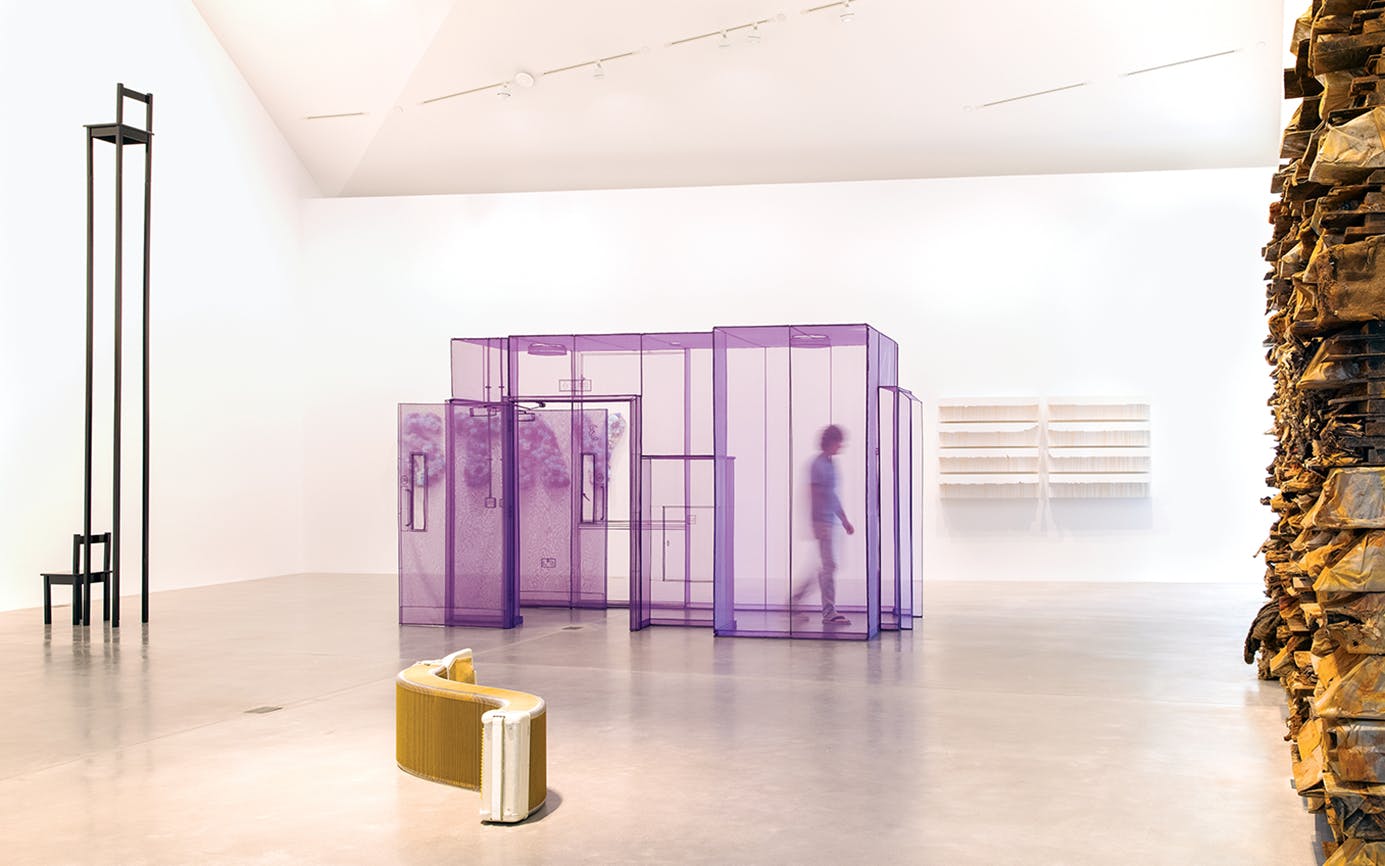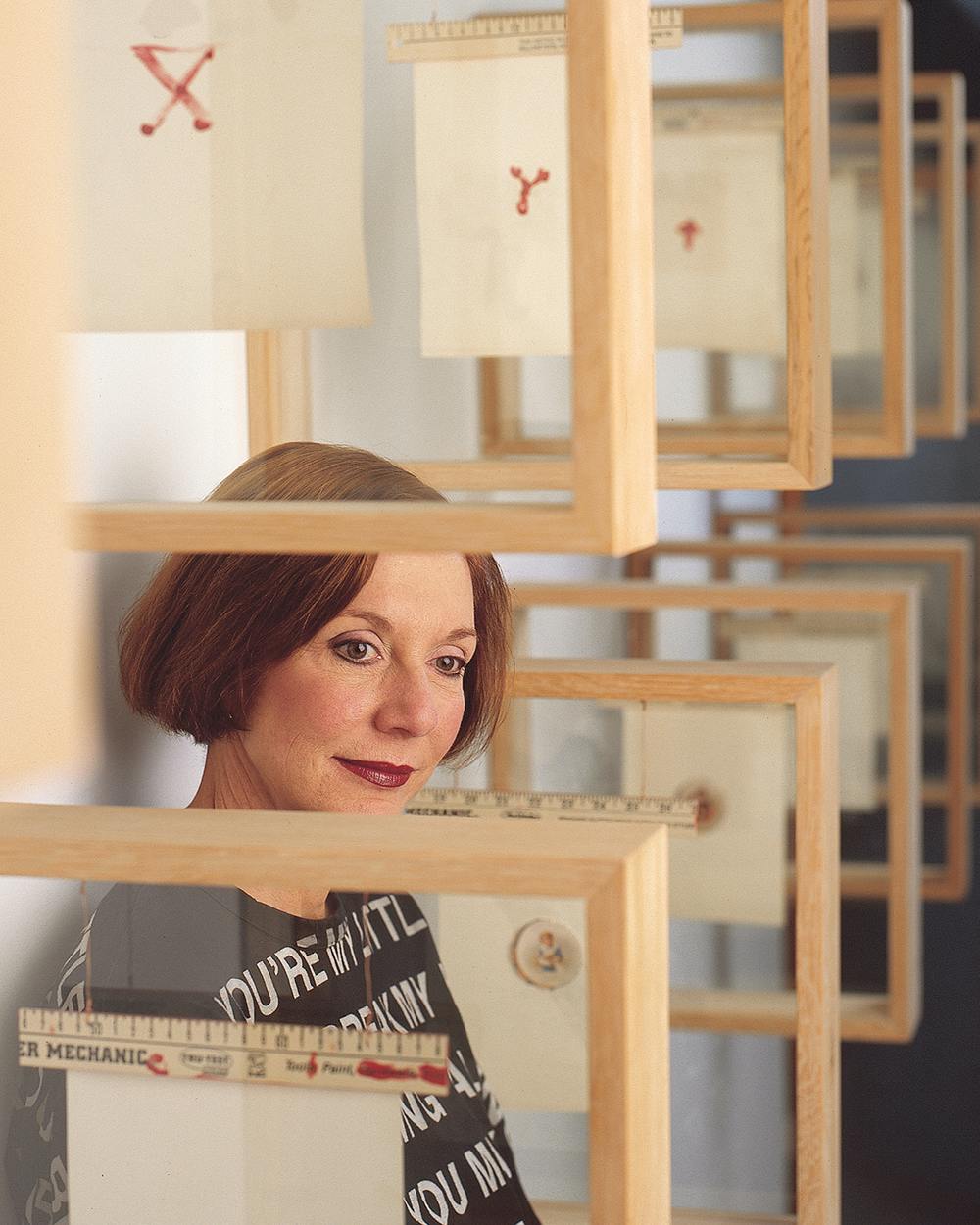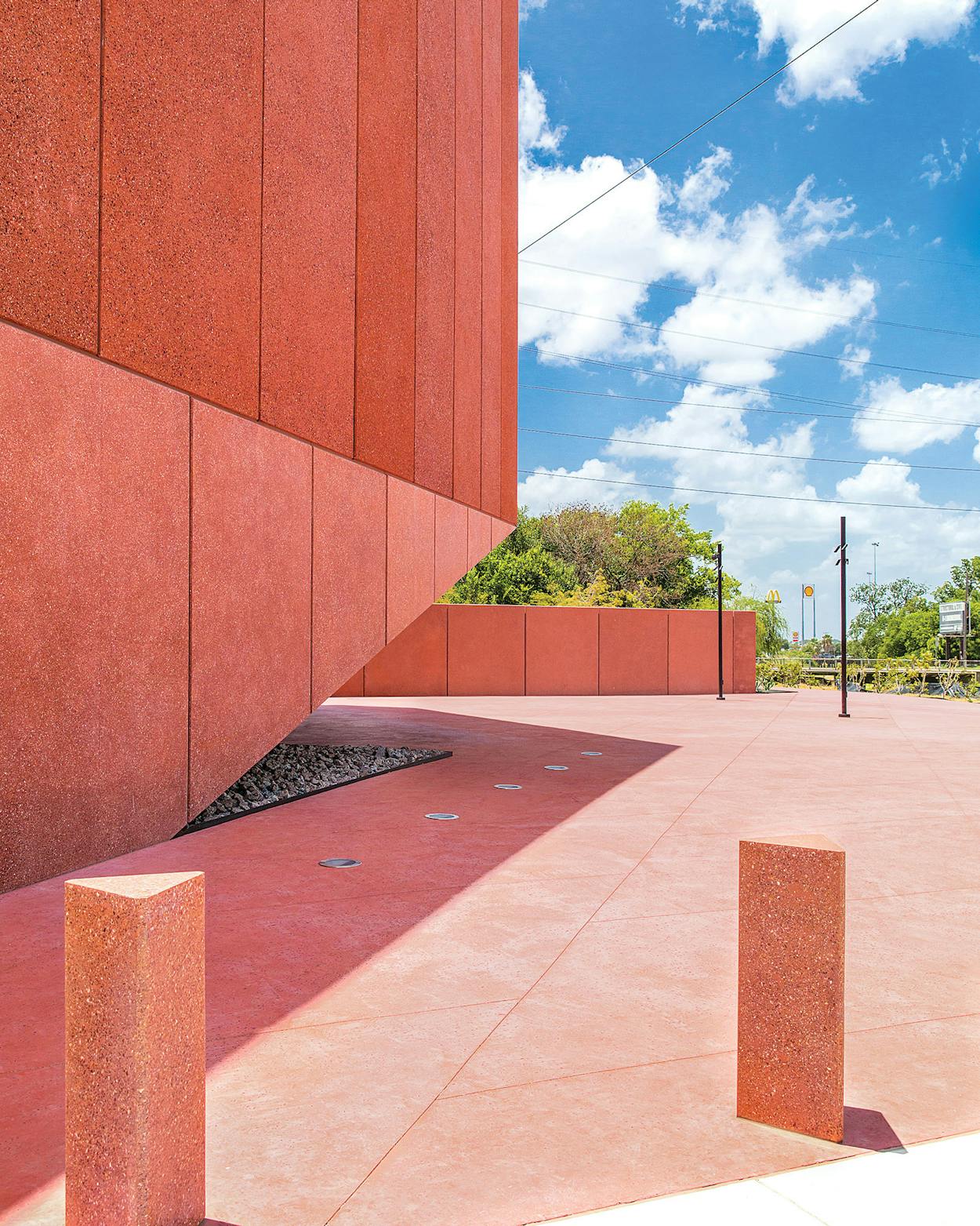Featured in the San Antonio City Guide
Discover the best things to eat, drink, and do in San Antonio with our expertly curated city guides. Explore the San Antonio City Guide
The story of Ruby City—the landmark museum designed by world-renowned architect Sir David Adjaye that opens this month—begins with the lucid dream of a dying woman. In the spring of 2007, Linda Pace, at age 62 a legendary patron of contemporary art in San Antonio, understood that her breast cancer, diagnosed a few months earlier, was likely terminal. All the money in the world could not keep the woman born into both the Pearl beer and Pace Foods families alive long enough to see through her final project, a permanent home for her art collection.
Still, Pace wanted to push the museum plans over the hump into inevitability before her time ran out. This meant, according to the creative method and cosmology to which she subscribed, that there were dreams to be hatched. So, as she awaited Adjaye’s initial site visit that May, Pace also awaited a specific dream, one that would reveal to her a vision for how to proceed with the building.
“Linda practiced dream-tending,” explains Kelly O’Connor, head of collections and communications at Ruby City and Pace’s studio assistant in her last years. For decades, Pace had kept paper and a large container of colored pencils at her bedside, the better to capture images before they escaped from memory upon waking. So when she had visions of her museum before Adjaye’s arrival, she was ready. “Having the dream of Ruby City wasn’t completely just this accident—it was like she had called forth the dream,” O’Connor says.
Pace gave Adjaye three drawings of her dream of an enchanted city—an enticing citadel of minarets in reds, pinks, and purples, glimpsed from afar, at the end of a serpentine path. The Emerald City in The Wizard of Oz comes to mind as a likely subconscious inspiration, as does the question of an afterlife. Less than two months after Adjaye’s visit, Pace died.
“When I got this sketch, I felt like, ‘Oh, this is sort of like a puzzle,’ ” recalls Adjaye, who was then an up-and-coming British architect. “But it seemed to unlock itself for me. I thought it was a kind of dense poem, a dense meditation on all that she wanted to have.” Now one of the most sought-after architects on the planet, he has designed high-profile buildings such as the National Museum of African American History and Culture, in Washington, D.C.; the Museum of Contemporary Art, in Denver; and the Nobel Peace Center, in Oslo. Ruby City is his first project in Texas.

At first glance, Adjaye’s building has little in common with Pace’s drawings, except for the red concrete exterior, an articulated roofline, and a sense of upward motion. Inside, however, there is the idea of a circuit to be followed—if not a literal yellow-brick road, then very much a pathway into magic and the unknown—leading visitors up from a shaded first-floor reception area into a bright second story of angled ceilings, high and panoramic windows, and large galleries where most of the art lives. At 14,472 square feet, the building isn’t big by museum standards, but Adjaye has created a space that seems (thanks in part to a double-cantilevered base) to hover above its surroundings, rarefied by the special quality of light it admits—in his own words, it’s a “little temple of art.”
Free to visitors, the $16 million museum will showcase more than forty pieces from Pace’s deeply personal art collection, many of them large-scale and immersive. So far, public anticipation is proving Pace’s dream vision to be prescient. Across creative communities in the city, state, and beyond, there is a magnetic sense of curiosity and possibility about this new jewel of downtown San Antonio’s art scene as the October 13 opening festivities approach.
The daughter of Margaret Bosshardt, whose family once owned the Pearl Brewery, and David Pace, who founded Pace Foods in 1947, Linda Pace grew up at the apex of mid-twentieth-century San Antonio society. In a 2003 book she co-authored, Dreaming Red: Creating ArtPace, she paints a picture of a family strained by money and tradition, with a socialite mother often clashing with a “tinkerer” father who spent weekends experimenting with salsas in his jalapeño garden. As an undergraduate at the University of Texas at Austin, Pace had an unrequited love affair with visual art; a professor squashed her ambitions, offering to boost her grade to a C so long as she promised never to paint again. Pace soon dropped out to marry her hometown sweetheart, Christopher “Kit” Goldsbury. She writes of sitting at home after their wedding with nothing to do but compose thank-you notes, wondering, “Is this all there is?”
In many ways, Pace’s real story began at age 42, when her divorce from Goldsbury (they had two children, both now deceased) and the sale of her stake in the family business led her to toss out the script of her traditional upbringing. “To leave someone else’s idea of a fairytale and set out to find my own way was a radical, unconventional act, one that shook me to my bones,” Pace writes. “The only clues I had to where I was going were found in my nightly dreams.”

THE PATRON AS AN ARTIST
Several pieces made by Pace herself will be on display at Ruby City, including the ambitious Red Project (2001), an assemblage of dolls, toy jewelry, and other detritus of consumer culture, much of it evocative of feminist themes.
Pace would become a self-authored woman, improvising a new script, inspired by influences including Houston art-world grande dame Dominique de Menil; the post-Freudian dream-symbolism philosophy of Carl Jung; and the various world-renowned artists whose studio practices she sampled and shared through ArtPace, the art residency program she founded in San Antonio in 1993. The prominent British video artist Isaac Julien, a major focal point of Ruby City’s collection, calls ArtPace “one of the most important art residencies in the United States.” The program has transformed the San Antonio art community, building lasting connections between globe-trotting art stars, in-the-know curators from around the world, and the local talent pool. Artists who received a boost from ArtPace include marquee names like Julien, Mona Hatoum, Glenn Ligon, and Trevor Paglen, as well as a nearly exhaustive roster of notable Texas artists, from Jesse Amado to Mel Zeigler.
Though her friends say she was an introvert, Pace saw her role as a connector of artists and dreamers, with a particular focus on women and those from historically underrepresented groups. Kathryn Kanjo, director and CEO of the Museum of Contemporary Art San Diego and a trustee of the Linda Pace Foundation, which oversees Ruby City, recalls Pace hosting art-world gatherings at her other homes in London, New York, and Aspen that would last well into the night. Similarly, O’Connor fondly remembers Pace’s hectic but welcoming downtown San Antonio apartment on Camp Street, where she always kept a quesadilla station (including several varieties of her family’s picante sauce) available in her kitchen for visitors who needed a quick snack.
For artists, the generosity of ArtPace’s stipends, not to mention Pace’s purchasing power as a collector, could be a godsend. But the depth of her commitment to them transcended the traditional patronage role. “Because Linda actually made art herself, it meant that she completely understood the artist’s quest and the artist’s desires and demands,” says Julien, whose ArtPace residency in 1999 led to a close friendship with Pace. He would later introduce Adjaye to Pace and travel with the architect to San Antonio for the May 2007 site visit.

On that trip, Adjaye also toured San Antonio’s missions, where he became enamored of the quality of light through the colonnades and the idea of a walkable circuit as a meditative tool. He was able to show Pace initial sketches for his design for the museum before she died, although construction, delayed in part by the recession, would not begin until 2017. Nor is Ruby City entirely finished. Over the next few years, an amphitheater will be constructed, connecting the museum’s sculpture garden to adjacent San Pedro Creek. “We think that when that’s complete, the public nature of the project will be fully revealed,” Adjaye said during a public talk he gave in San Antonio earlier this year.
Pace’s sensibility hovers over the Ruby City collection. The opening exhibit, a selection of paintings, photos, and sculptures curated by Kanjo that will be on display for the next two years, is called “Waking Dream.” Many of these works reimagine familiar objects and spaces in altered or ghostlike forms, and several are interactive. Sculptor Do Ho Suh’s Hub, 3rd Floor, Union Wharf, 23 Wenlock Road, London N1 7ST, UK (2016) re-creates the layout and walls of the artist’s apartment through the use of polyester fabric scrims. Visitors are welcome to walk through this delicate, exposed space. Marina Abramović’s Chair for Man and His Spirit (1993) is composed of two chairs—one at normal height, where the visitor is invited to sit, and the other more than sixteen feet tall, near the level of what Adjaye calls his “zenithal light”—a favorite phrase of his referring to light that comes from above.
Kanjo notes that much of the artwork from Pace’s collection is rooted in themes related to identity, struggle, and domesticity—preoccupations that were undervalued in the 1990s and 2000s art markets but have become hot topics in recent years. “She might have been setting trends, but she wasn’t following them,” Kanjo says.
One of the more moving pieces is British artist Cornelia Parker’s sculpture Heart of Darkness (2004), composed of burnt wood from a forest fire suspended in space with florist wire so that, against a white gallery backdrop, it reads almost like an abstract, three-dimensional ink drawing. Parker had a major career breakthrough as a 1997 resident of ArtPace, where she created her first burnt-wood sculpture, Mass (Colder Darker Matter), from the charred beams of a lightning-struck African American church in Lytle, near San Antonio. The sculpture was nominated for that year’s Turner Prize, the UK’s most prestigious art award.
Ruby City also devotes one large room to Julien’s multichannel video works, which will change out a bit more often than the “Waking Dream” pieces—perhaps once a year. The first up is Playtime (2013), a sort of farce on the global art market, starring James Franco as an art dealer.
Additional works by Julien, Pace, and others will be exhibited on a semiannual basis in Ruby City’s auxiliary gallery, Studio, located across the street in Chris Park, a one-acre green space that opened in 2005. The park was designed by Teresita Fernández after the 1997 death of Pace’s son, Chris, at age 24, from a drug overdose. The park also includes an installation of lights recessed in a concrete walk that, from above at night, resembles the constellations from the night that Chris was born; Pace could see it from her Camp Street apartment in her last years. Chris Park can be understood as a tribute to and respite for the eternal soul of Pace’s troubled son. “His journey continues in a spiritual way that I cannot fathom,” she writes in Dreaming Red.
It’s hard not to see Ruby City as an equivalent endeavor, undertaken at the end of her life, to build a monument to carry Pace’s dreams into the future of her hometown. “I feel like Linda is the building,” O’Connor says. “She is throughout this space. She is Ruby City.”
This article originally appeared in the October 2019 issue of Texas Monthly with the headline “Over the Rainbow.” Subscribe today.
- More About:
- Style & Design
- Art
- Architecture
- San Antonio







